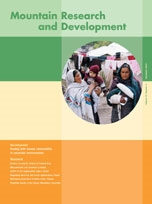This quantitative study assesses the ecological impacts of varying degrees of forest use, describing community structure, population structure, and regenerative capacity of the understudied but much utilized Quercus semecarpifolia Sm. in a mixed oak and Rhododendron arboreum Sm. forest. The Middle Hills of the Himalayas have long traditions of mixed farming, with animal husbandry and agriculture as interdependent components. Major biomass demands come from grazing and collection of fodder and fuelwood. In forested areas lopped fodder is one of the main components, and as elevation increases, so does its importance. Human impact has been used to explain low regeneration of these evergreen oaks. The anthropogenic disturbance gradient spanned from highly disturbed savanna-like sites to minimally disturbed shaded sites dominated by rhododendron. The population structure showed a bell-shaped distribution with a pronounced under-representation of saplings throughout the forest. Data indicated the best regeneration in the least disturbed sites. The degree of lopping was the best explanatory variable for the distribution of recruits. Factors preventing trees from surviving the sapling phase may inhibit long-term regeneration more than factors causing high seedling mortality. Results indicate that regeneration of Q. semecarpifolia may suffer to the benefit of rhododendron, which escapes biotic stress due to its poor fodder and fuelwood qualities.
How to translate text using browser tools
1 November 2007
Does Regulated Land Use Allow Regeneration of Keystone Forest Species in the Annapurna Conservation Area, Central Himalaya
Inger Elisabeth Måren,
Ole Reidar Vetaas
conservation
human impact
lopping
Middle Hills
Nepal
oak forests
recruitment





